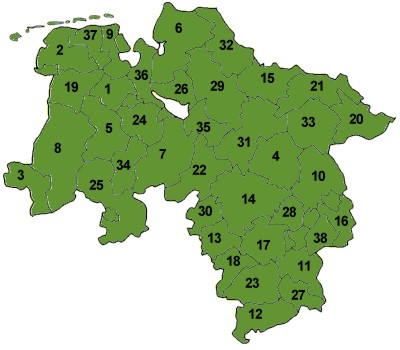Lower Saxony
|
|
| Flag | |
|---|---|
| Missing image Flag_de-niedersachsen_300px.png State flag of Lower Saxony | |
| Coat-of-arms | |
| Missing image Coa_de-niedersachsen_300px.png State coat-of-arms of Lower Saxony | |
| Statistics | |
| Capital: | Hanover |
| Area: | 47,618 km² |
| Inhabitants: | 8,002,916 September 30, 2004 |
| pop. density: | 168 inh./km² |
| Homepage: | niedersachsen.de (http://www.niedersachsen.de/) |
| ISO 3166-2: | DE-NI | Politics |
| Minister-president: | Christian Wulff (CDU) |
| Ruling party: | CDU/FDP |
| Map | |
| Missing image Germany_Laender_Niedersachsen.png | |
With an area of 47,618 km² and nearly eight million inhabitants, Lower Saxony (German: Niedersachsen) [ˈniːdɐˌzakzn]) lies in north-western Germany and is second in area and fourth in population among the country's sixteen Bundesländer (federal states). In rural areas Low Saxon is still spoken, but the number of speakers is declining.
| Contents |
Geography
Lower Saxony borders on (from north and clockwise) the North Sea, the states of Schleswig-Holstein, Hamburg, Mecklenburg-Western Pomerania, Brandenburg, Saxony-Anhalt, Thuringia, Hesse and North Rhine-Westphalia, and the Kingdom of the Netherlands. The state of Bremen forms two enclaves within Lower Saxony. The state's principal cities include Hanover, Braunschweig (Brunswick), Osnabrück, Oldenburg, and Göttingen.
The northwestern portion of Lower Saxony is a part of Frisia; it is called Ostfriesland (Eastern Frisia) and lies on the coast of the North Sea. It includes seven islands, known as the East Frisian Islands. In the southwest of Lower Saxony is the Emsland, a sparsely populated area, once full of inaccessible swamps. The northern half of Lower Saxony is absolutely flat, but there are two mountain chains in the south: the Weserbergland ("Weser Hilly Region") and the Harz. The middle of the state houses the largest cities and the economic centres: Hanover, Hildesheim, Wolfsburg, Salzgitter and Braunschweig. The region in the northeast is called Lüneburger Heide (Lüneburg Heath), the largest heath of Germany and in medieval times wealthy due to the salt trade. To the north the Elbe river separates Lower Saxony from Hamburg, Schleswig-Holstein, Mecklenburg-Western Pomerania and Brandenburg. The lands on the southern banks are called Altes Land (literally "Old Land"), and they are characterised by thousands of fruit-trees.
See also List of places in Lower Saxony.
Lower Saxony is divided into 38 districts (Landkreise or simply Kreise):

| ||
Furthermore there are eight independent towns, which do not belong to any district:
History
The area is named for the Saxons, who moved there from what is today the neighbouring state of Schleswig-Holstein towards the middle of the 1st millennium AD. Originally the region was simply called Saxony, but as the center of gravity of the Duchy of Saxony gradually moved up the Elbe, towards the present-day states of Saxony-Anhalt and Saxony, the region was given the name of Lower Saxony, which it bore as an Imperial Circle Estate from the late 15th century on.
The state was founded in 1946 by the British military administration, who merged the former states of Brunswick-Lüneburg, Oldenburg, and Schaumburg-Lippe with the former Prussian province of Hanover.
After the Second World War, the military authorities appointed the first Legislative Assembly (Landtag) in 1946, followed by a direct election of Lower Saxony's legislature a year later. It resulted in the election of Social Democrat leader Hinrich Wilhelm Kopf, who became the first prime minister. Kopf led a five-party coalition, whose basic task was to rebuild a state affected by the war's rigours. Kopf's cabinet had to organise an improvement of food supplies and the reconstruction of the cities and towns destroyed by the Allied air raids of the war years. In addition, the first state government also faced the challenge of integrating hundreds of thousands of refugees from Germany's former territories in the east (such as Silesia and East Prussia), which had been annexed by Poland and the Soviet Union.
Between 1978 and 2004, the state's districts and independent towns were grouped into four administrative regions (Regierungsbezirke):
- Braunschweig (Brunswick)
- Hanover (Hannover)
- Lüneburg
- Weser-Ems
Politics
The political direction of the State of Lower Saxony has evolved and has been a reflection of its times. In general terms, the political preferences of Lower Saxony's citizens tend to be oriented along the lines of Germany's federal politics. Basically, the parties constituting the federal government could often rely on a state administration sympathetic to its policy aims. Particularly in recent times, however, this rule has given way to a more flexible and, to some extent, volatile attitude amongst voters in one of Germany's most populous states.
List of minister presidents of Lower Saxony
- 1946 - 1955: Hinrich Wilhelm Kopf (SPD)
- 1955 - 1959: Heinrich Hellwege (DP)
- 1959 - 1961: Hinrich Wilhelm Kopf (SPD)
- 1961 - 1970: Georg Diederichs (SPD)
- 1970 - 1976: Alfred Kubel (SPD)
- 1976 - 1990: Ernst Albrecht (CDU)
- 1990 - 1998: Gerhard Schröder (SPD)
- 1998 - 1999: Gerhard Glogowski (SPD)
- 1999 - 2003: Sigmar Gabriel (SPD)
- since 2003: Christian Wulff (CDU)
External links
- Official governmental portal (http://www.niedersachsen.de/)
Template:Germany statesda:Niedersachsen de:Niedersachsen et:Alam-Saksi es:Baja Sajonia eo:Malsupra Saksio fa:نیدرزاکسن fr:Basse-Saxe ko:니더작센 주 it:Bassa Sassonia he:סקסוניה התחתונה ka:ქვემო საქსონია la:Saxonia Inferior nl:Nedersaksen nds:Neddersassen ja:ニーダーザクセン州 no:Niedersachsen pl:Dolna Saksonia pt:Baixa Saxônia ro:Saxonia Inferioară ru:Нижняя Саксония simple:Lower Saxony sk:Dolné Sasko fi:Niedersachsen sv:Niedersachsen
